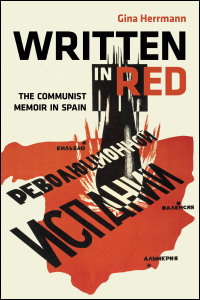Book Review: Lives of the Left
 Written in Red: The Communist Memoir in Spain. By Gina Herrmann. University of Illinois Press, 2010.
Written in Red: The Communist Memoir in Spain. By Gina Herrmann. University of Illinois Press, 2010.
Written in Red analyzes the life writing of six Spanish Communists: Dolores Ibárurri, Jorge Semprún, Rafael Alberti, María Teresa León, Teresa Pàmies and Tomás Pàmies. Notwithstanding significant stylistic and political differences, their writing shares a preoccupation with the personal and political legacies of civil war and exile. As Herrmann notes, “these writers represent familiar roles lived out by the kind of people who were attracted to Communism: party leader, intellectual, artist, resistance fighter, journalist, and proletarian.” Equally importantly, they represent different relationships to Communism and to Stalinism—a major theme throughout the book.
As the first detailed study of Communist memoir in 20th century Spain, this book offers a brilliant analysis of the relationship between political commitment and activism, personal relations and affect. Of particular interest to scholars of Spanish history, politics and literature, it should also be read by students of Communist culture, since it locates Spain within the field of Communist cultural studies and draws on an impressive array of comparative works from the former USSR, Eastern Europe, and the United States. While not a straightforward history of the civil war or the Communist Party, this literary study admirably contextualizes the works in question within this larger history. Its engagement with a range of contemporary theorists sets it in the best tradition of literary and cultural studies.
The book revolves around two sets of fundamental tensions: between conviction and remorse, and between the individual life and “the social and collective terms within which the Communist subject was supposed to understand and present him or herself.” The movement back and forth between common themes and political and aesthetic differences is facilitated by the book’s structure. With the exception of the first chapter, dedicated to Ibárruri’s autobiography, the book reads two or more writers alongside each other, bringing out convergences and tensions between them and Communist memoir. Chapter 2 examines the memoirists’ early lives and their conversion to Communism. Chapter 3—appropriately the center of the book—covers the war in Spain. Reflecting the recent “affective turn” in the humanities, political and personal legacies of the conflict are examined through emotional expression in the memoirs: happiness, shame, love, guilt. While the central distinction is between women’s and men’s memories of war, it is here that the common features in the work of all six writers are brought out most clearly.
In the final chapters, the categories “organic” and “dissolutive” Communist memoir are put to productive use. Chapter 4 examines Léon and Alberti—wife and husband, lifelong Communist artists, and prominent figures in the Spanish exile community. Drawing on Walter Benjamin’s concept of “Left Melancholia” and Wendy Brown’s more recent reworking of this, Herrmann explores the haunting themes of exile, nostalgia, and melancholia. Alberti is—alongside Semprún—the most famous writer among these memoirists and occupies a privileged position within Spain as a respected poet. Perhaps as a caution against the mythologizing of heroes common to all wars, Herrmann highlights Alberti’s complicity in the silences surrounding the atrocities of Stalinism. Most intriguing and original here is her use of Alice Kuzniar’s work on dogs and melancholia to contrast Alberti’s obsessive representation of canine pets with the absence of Stalinist horrors: “So little Communism, so many dogs.”
Another absence in Alberti’s memoir is his wife, with whom he lived for the entire period of the war and exile; the contrast between the prominent place of Alberti in Leon’s memoir and his almost total failure to mention her is one example of the gender analysis that weaves through the book.
Building on her previous work on female militant memories of the civil war, Herrmann analyzes Ibárruri’s performance of political motherhood and widowhood and contrasts women’s ambivalent feelings about the war experience with men’s expressions of shame in the face of ideals of masculinity in conflict. The gender politics of activism and writing are traced as well in the analysis of Testament à Praga, in which Teresa Pàmies intersperses her critical commentary with excerpts from diaries of her father, Tomás, a lifelong Communist activist and civil war veteran who never broke with the Party. This daughter-father dialogue also redresses the absence of Rosa, Teresa’s mother, from Tomás’s narrative. Reading texts in relation to one another highlights themes of absence and shame in the overlapping spheres of the personal and political.
Teresa Pàmies’s autobiographical corpus is, alongside that of Jorge Semprún, an example of the “dissolutive” memoir, and the two authors are the subjects of the final chapter. With the turn to these “compulsive, serial autobiographers,” the book comes to the end of its trajectory: from youth and conversion through war and activism and finally to the “deconversion memoir.” The turning point in both cases is the 1952 Prague show trials.
Herrmann resists any temptation of a triumphant reading of the work of Pàmies and Semprún as post-Communist, insisting that even as they refuse to hide from the horrors of Stalinism, both writers show ongoing commitment to Communist values of solidarity. Citing the scholar of American Communist writing Charity Scribner, Herrmann labels the works of Pàmies and Semprún “requiems for Communism” for their “refusal to accept the fait accompli of late capitalism as the only imaginable frame of our world.” This conclusion is simultaneously conscious of the historical context out of which these memoirs emerge. Like the dissolutive Communist memoirs with which it closes, the book stresses the enormity of the losses brought by the Communist project while expressing an awareness of what has been lost with its demise.
Carrie Hamilton teaches history at Roehampton University, London. She is the author of Women and ETA: The Gender Politics of Radical Basque Nationalism (2007).












